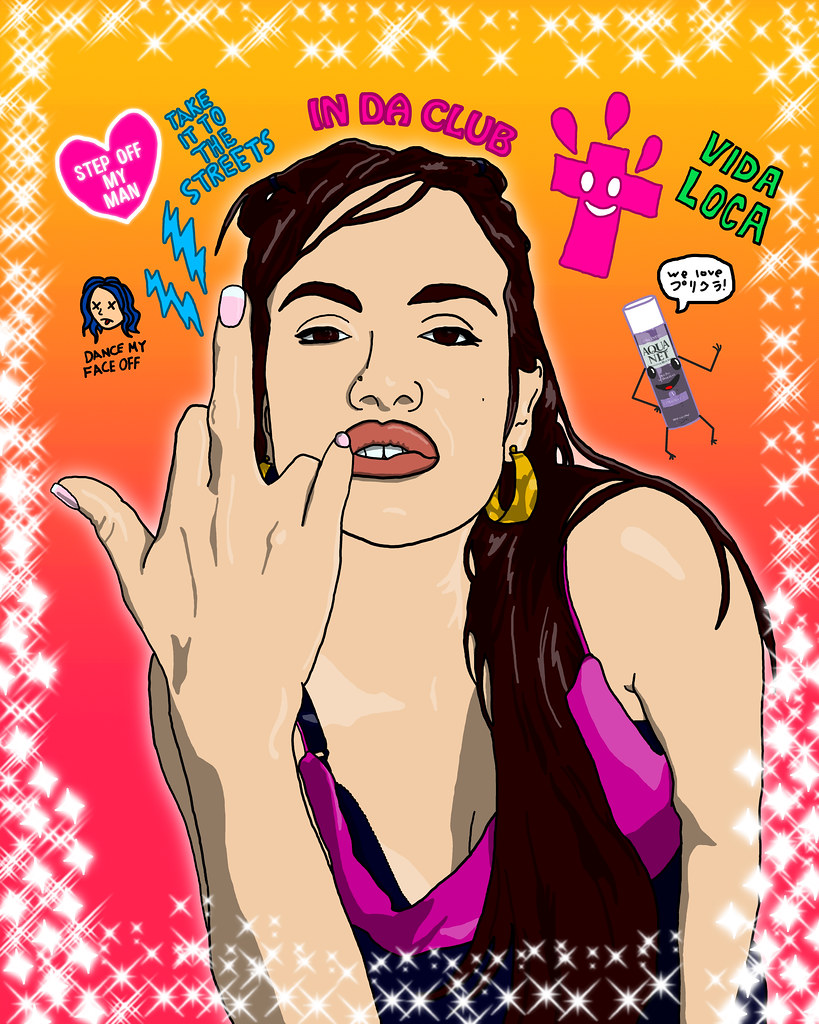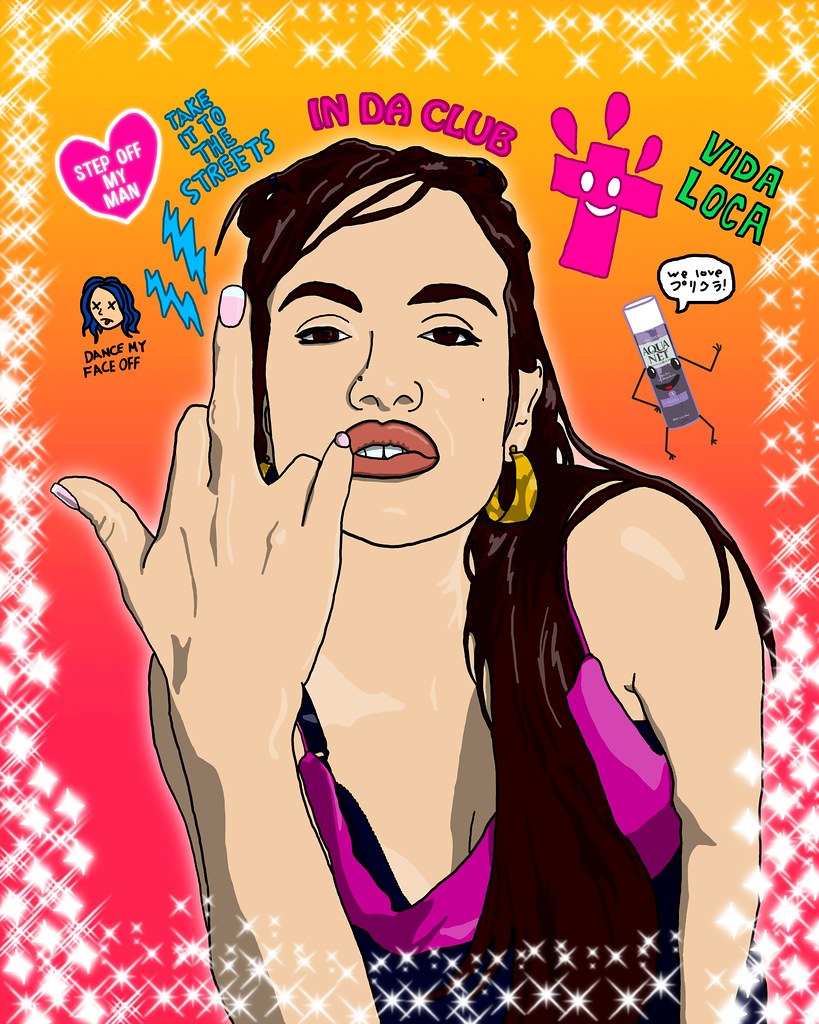If I haven't mentioned it before, I am quite the fan of awful horrible animated gifs. As I continue to work with seeNoga and Rio Yañez on the Jewish characters from Acciones Plásticas プリクラ: The Jewess Blogging Queen, The Avodah Girl and The 612er; I thought I would share this terrible image created early on in our collaboration. There is also another version (which I can no longer find) where in last frame of the gif sequence, it rains diet cokes. :)
a guest post by seenoga
a guest post by seeNoga.
As you doggedly pursue, chase, and snap at the heels of your Self, you do so knowing there is no chance you will ever catch up. For each of us, throughout our individual lives, we will be ever distant from knowing our own selves. When a person pursues his or her Self in an aggressive, determined way, the resulting hyperactive sensibility allows for a greater adaptability and sensitivity. This flexibility can be useful in contemporary human life, but only to a certain extent. It is also due to the fast-paced nature of today’s engineered environments, that there is a strong tendency (especially among young people) to go to extreme lengths in order to sustain within their own lives the hyperactivity and intensity they witness in popular culture and media. Consider the called-for constant reachability via cell-phones and laptops, as well as many other forms of expedition in our ‘lived-in’ world. These accommodations range from aerodynamics to ATMs. As many workers in today’s professional world simultaneously lament and extol their parasitic relationships with a Blackberry or other such Pocket God, I, too, have at many times felt chained to my laptop (i.e. the Internet), fearing I would miss something absolutely critical. Unfortunately, the fact that missing anything important has not happened for the most part, hardly affects the worry and anxiety that it might happen.Yet still, it seems, this once motivating anxiety is becoming a repressed urge, one which is less and less a bother, the more my environment becomes one seamless, semi-omniscient “news” feed. On the evening of President Barack Obama’s Address to the Nation, Maya Escobar recorded “Obama Tweet: How a New Generation Gets Their Information.” In this video Escobar documented a particular event, an important cultural event, one which incidentally brought the use of Twitter to the fore in popular culture.[youtube= http://www.youtube.com/watch?v=359HwupsY1s]
Obama Tweet: How a New Generation Gets Their Information, 2008
I was with Escobar on this evening and was struck by the depth of her interaction with the digital realm. She was sitting in front of a T.V. broadcast of the speech, while she was also further mediating that media via her computer, on which she was following Twitter and CNN.com’s coverage of the event. Beyond all that, Escobar was creating her own real-time, indexical document of the event on television along with CNN and Twitter as instantaneous forms of annotations to the President's speech. Escobar was watching, sitting one more stage removed, behind the lens of a video camera. Because of the way in which she layered the television screen the computer screen and then the interface of any viewer's monitor, Escobar has effortlessly choreographed a multi-layered, engagement with the very most current of events. However, though I may have somewhat qualified and rationalized instant-communication tools, I still believe there must be a deliberate effort to complement those socially-prescribed media with other, independent forms of digital exchanges. While I do believe in the great social potential of our rapidly advancing communications media, my work seeks to push and pull on parts of these evolving global ‘informachines,’ in an effort to challenge the omnipresence of commercial media.[youtube=http://www.youtube.com/watch?v=d0ZvYQOp89I]
Look Out, 2008
That sort of layering of non-dimensional spaces is unique to the contemporary world, with the inception of digital technologies, and this collage-like aesthetic is of great interest to the work of Maya Escobar, as much as it is to my own. Although, unlike the deceptively referential works of my counter-part, in many of my works, I use and refer to popular media sources and specific Internet sites indirectly and rarely with any superficial visibility. It is with great deliberation and much hypothesizing that I curate my works in the manner in which I do. I intend my works to avoid specificity and leave wide-open their readings to a much more self-guided analysis by viewers. In the piece “Look Out,” the projected video came directly from YouTube. I simply cut off the last second of the original video, thus shortening it to 17 seconds. I then prepared it as a video-loop for its installation underneath a staircase at the Mildred Lane Kemper Art Museum. Because of its placement, where it fills a theretofore, unaddressed space, it is as though the rolling image is part of the museum structure itself. The particular clip, which I chose after viewing dozens of similarly tagged videos (‘storm,’ ‘tree,’ ‘willow,’ and ‘weeping’), was selected for very specific compositional reasons; reasons which are the very same principles of design taught to anyone working in commercial design or the visual arts: complimentary colors, rule of thirds, dynamic composition and varied textures, to name a few. Because of my focused selection process, this video, although created for very different (and unknown) reasons, still fits very well into the installation space as a deliberately designed, and potentially permanent use of what is otherwise a neglected space. The video became part of the stairwell. By existing within a predetermined, architectural frame, it became part of the space, as opposed to sitting on the surface as a painting does. This projection did not exist in the way that many (most) installations do: as obvious alterations or obtrusive interjections into a space. This work asserts itself as a physical part of the space, as the projector beams through from behind the scrim in the stairwell. It also assumes a living presence, as it reiterates itself, by many reflections and refractions, split and scattered, bouncing around the main hall of the museum. The video functioned as a decorative element but also an illusory window to an outside world, whereas, the space without that piece is simply a pane of glass that looks into the shadowy crotch of a stairwell. I do not mean every square inch should be taken up for some sort of visual activity or illusionary window. Simply, this work proposes how our constructed spaces, in this case a venue for art viewing, might be reinterpreted. Insofar as, a corner can conceivably become a window, as illusory and impermanent as my particular interpretation may be.
*NOESCO is seeNoga and maya escobar
acciones plásticas goes プリクラ chicano style
Acciones Plásticas プリクラ
Acciones Plásticas プリクラ is a collaboration between artists Maya Escobar and Rio Yañez.
 The Latina Hipstera bad-ass Morrissey-lovin’, tuff-girl sexy chica
The Latina Hipstera bad-ass Morrissey-lovin’, tuff-girl sexy chica The Latina Role Modela diploma totin’ intellectual, sexy, social media goddess
The Latina Role Modela diploma totin’ intellectual, sexy, social media goddess The Homegirla hybridized version of Escobar’s Midwestern Chach and Yañez’s West Coast Chola.In Acciones Plásticas Escobar created a multi-faceted “doll” by assuming the role of designer and distributor, and even posing as the actual doll itself. Each doll was a satirical characterization of some of the many roles that have been projected upon her, and into which she has, at points, inevitably fallen. In conjunction with these images, she developed a short series of low-definition youtube video blogs through which she inhabits the lives of “real women” who have each been visibly defined by societal constructs.Recently, Yañez has been utilizing Japanese photobooths (known as Purikura or “print-club”) as an artist’s tool for creating portraits. These booths are much more common in Japan than their United States counterparts. As a catalyst for creative expression and social interaction they are used primarily by young urban Japanese girls. A standard feature in all Purikura booths allows the user to digitally decorate their portraits after they take them. The options are vast and include wild characters, excessive starbursts of light, pre-made phrases and the option to draw your own text directly on the image. Purikura gives the subjects near-divine powers of self-expression in crafting their own portraits.The two artists who met over the web, decided to bring together Escobar’s highly charged and evocative Acciones Plásticas characters with Yanez’s notorious Chicano graphic-art style and new found obsession with Purikura images, as a way of addressing the construction of Latina identities.Maya posed as The Latina Hipster: a bad-ass Morrissey-lovin’, tuff-girl sexy chica; The Latina Role Model: a diploma totin’ intellectual, sexy, social media goddess; and finally, The Homegirl: a hybridized version of Escobar’s Midwestern Chach (or Chachi Mama) and Yañez’s West Coast Chola. Maya sent digital images to Rio, who in turn drew portraits of her as each of these constructed identities. He approached each portrait with a Purikura sensibility and decorated them each as the characters represented might accessorize themselves. The final series of portraits is the result of negotiating multiple identities and influences. Guatemalan, Jewish, and Chicano sensibilities reflected back through a Japanese Purikura aesthetic. Acciones Plásticas プリクラ challenge and question the thin line between archetype and stereotype. The Purikura elements present the novel signifiers of each social construct represented in the series.This collaboration is the first of many to come as Maya and Rio explore the commonalities and differences of their cultural identities.For more information on Acciones Plásticas プリクラcheck out Rio's blog and stay tuned for guest post by seeNoga aka Carianne Noga on meeting the Chach Homegirl in real life.(video of the Chach featured below)[youtube=http://www.youtube.com/watch?v=Xj3Q42YF40Y]
The Homegirla hybridized version of Escobar’s Midwestern Chach and Yañez’s West Coast Chola.In Acciones Plásticas Escobar created a multi-faceted “doll” by assuming the role of designer and distributor, and even posing as the actual doll itself. Each doll was a satirical characterization of some of the many roles that have been projected upon her, and into which she has, at points, inevitably fallen. In conjunction with these images, she developed a short series of low-definition youtube video blogs through which she inhabits the lives of “real women” who have each been visibly defined by societal constructs.Recently, Yañez has been utilizing Japanese photobooths (known as Purikura or “print-club”) as an artist’s tool for creating portraits. These booths are much more common in Japan than their United States counterparts. As a catalyst for creative expression and social interaction they are used primarily by young urban Japanese girls. A standard feature in all Purikura booths allows the user to digitally decorate their portraits after they take them. The options are vast and include wild characters, excessive starbursts of light, pre-made phrases and the option to draw your own text directly on the image. Purikura gives the subjects near-divine powers of self-expression in crafting their own portraits.The two artists who met over the web, decided to bring together Escobar’s highly charged and evocative Acciones Plásticas characters with Yanez’s notorious Chicano graphic-art style and new found obsession with Purikura images, as a way of addressing the construction of Latina identities.Maya posed as The Latina Hipster: a bad-ass Morrissey-lovin’, tuff-girl sexy chica; The Latina Role Model: a diploma totin’ intellectual, sexy, social media goddess; and finally, The Homegirl: a hybridized version of Escobar’s Midwestern Chach (or Chachi Mama) and Yañez’s West Coast Chola. Maya sent digital images to Rio, who in turn drew portraits of her as each of these constructed identities. He approached each portrait with a Purikura sensibility and decorated them each as the characters represented might accessorize themselves. The final series of portraits is the result of negotiating multiple identities and influences. Guatemalan, Jewish, and Chicano sensibilities reflected back through a Japanese Purikura aesthetic. Acciones Plásticas プリクラ challenge and question the thin line between archetype and stereotype. The Purikura elements present the novel signifiers of each social construct represented in the series.This collaboration is the first of many to come as Maya and Rio explore the commonalities and differences of their cultural identities.For more information on Acciones Plásticas プリクラcheck out Rio's blog and stay tuned for guest post by seeNoga aka Carianne Noga on meeting the Chach Homegirl in real life.(video of the Chach featured below)[youtube=http://www.youtube.com/watch?v=Xj3Q42YF40Y]
